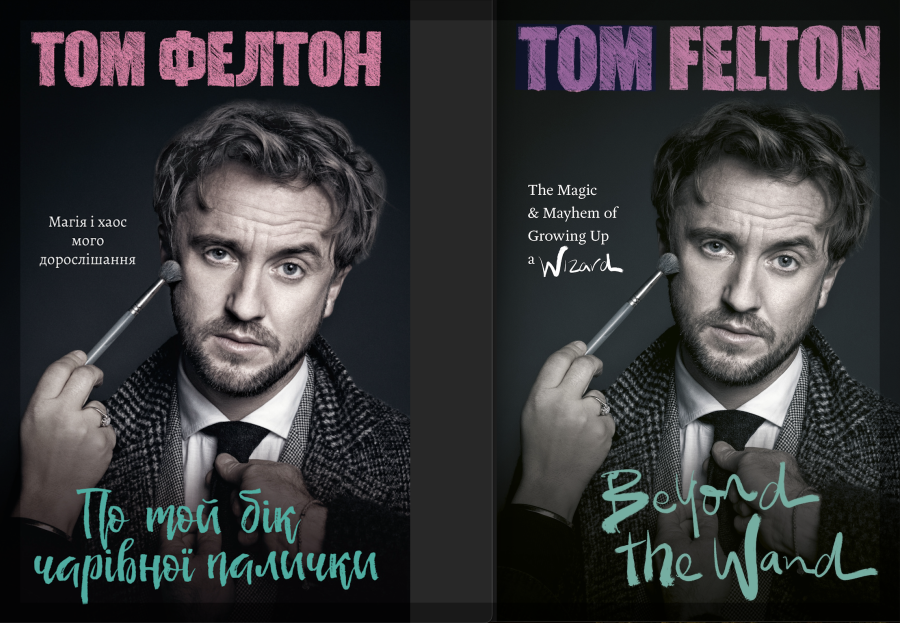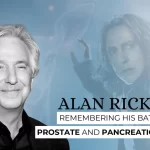This is a chapter from the book “Beyond the Wand” by Tom Felton.
«Perhaps you imagine a day’s filming at the Harry Potter studio set to be a day of wizarding glamour or Hollywood star treatment.
Allow me to burst your bubble.
Don’t get me wrong: being an actor on a film set certainly beats being at school. But I’ve found that the reality is different to most people’s expectation.
A typical studio day would start with a knock on my front door at six in the morning. It would be Jimmy (we affectionately called him Crack Bean), my driver of nine years, bright and perky and ready to take me to work. Like any teenager, I was the very opposite of bright and perky at that time of day. I would stumble reluctantly out of bed and walk zombie-like, clutching a pillow, to the car – a dark green BMW 7 Series with a long wheel base that I most definitely did not need. Ensconced in the passenger seat, I’d become an instant carcoleptic and snooze through the hour and a half it took to get from home to the studios, where Jimmy would drop me at the iconic Door 5.
Door 5 led to the dressing rooms, the production office and the art department. It was the shabbiest, most run-down block I’d ever seen. Old rickety stairs, sticky checkerboard lino on the floor. More often than not it would be pissing down with rain outside, or the Tupperware grey of the skies would remind you that this was definitely England, not Hollywood. Still bleary-eyed, I would go to find some breakfast in the canteen: hash browns and beans, good British stodge to fill up a hungry teenager. Then I’d stagger up those rickety stairs to the production office to get my ‘sides’. These were mini scripts that comprised the day’s order of play and the lines I’d need to know. I was the despair of the second assistant directors, whose job it was to produce and distribute the sides, because I was forever losing them. «Next stop: my dressing room. My route would take me through the art department. It was a truly astonishing place, where supremely talented artists sat round a long Gringotts-esque table, fashioning props for the wizarding world out of clay, or building exquisitely precise scale models of various sets. At the end of the art department was the office of David Heyman. «Being called there was like being called to see the headmaster, usually to discuss something important. Daniel, Emma and Rupert had their dressing rooms together at the end of one corridor, with a ping-pong table nearby (side note: young Emma Watson was a very adept ping-pong player). «My dressing room was on a different corridor. A plaque on the door said ‘Draco Malfoy’. It was the done thing for the plaques to give the character’s name rather than the actor’s. (For the fifth film, Alan Rickman changed the label on his dressing room door to ‘The Half-Blood Prince’.) «f anyone thought my dressing room would be a cocoon of outrageous comfort and privilege, they would be disabused of that notion once they’d stepped inside. It was a tiny room, painted white, with a metal clothes rail and a plastic chair. My Hogwarts robes – or whatever costume was required for the day – would be hanging on the rail. I’d change into it and make my way to hair and make-up. «Hair and make-up on the Potter films was a massive operation. The artists would have to get through twenty or thirty actors a day, and I’d probably spend an hour in the chair each morning, more if I was getting my roots done, which happened once every nine days. From time to time I’d go through all that and end up not even being used for the day’s filming. «(Timothy Spall once told me he acts for free – he’s only paid to wait.) We had to be there and ready on the off-chance we were needed for a scene, which often we weren’t. This could be a bit frustrating, though it was worse for someone like Warwick Davis, who played Professor Flitwick/Griphook. It would take three or four hours to apply his hair and make-up, and another couple of hours to remove it. A long time in the chair to end up not being called on set. «So now I’m in full Draco regalia, my robes are flowing and my bleached hair is just so. Which means it’s time to go to school. And the school in question, alas, was not Hogwarts, but another plain white room down another corridor where one of a number of tutors would be waiting for us. There was a legal requirement that all school-aged kids should receive a minimum of three hours of tutoring every day. «That requirement was literally observed to the millisecond: our time in tutoring was measured using stopwatches. The moment we picked our pens up, the clock was on. The moment we put them down to go to set, it was off. Even a five-minute stint would go towards our allotted three hours, and the stop-start nature of the process was hardly conducive to effective learning. «Not that I was particularly interested in learning effectively. I hated tutoring. It was nothing to do with the tutors; my mum had recommended Janet, who had tutored me on Anna and the King, and she headed up a team of tutors who did their very best with us. I’d be in a class of three, tops, often «with Jamie or Josh because we were generally filming in the same scenes, but my attention was always elsewhere. The moment the call came that we were needed for blocking, I was out of there. «There were eight stages at Leavesden, named A to H. Each stage was essentially a huge warehouse, where they would build the sets in astonishing detail. Into one warehouse they imported countless tons of topsoil and planted actual trees to create the Forbidden Forest. Another contained the water tank, which was the largest in the world at the time. As I’ve already mentioned, the Great Hall was a masterpiece, situated in the final stage, furthest from Door 5. It was a long walk or, if you were lucky, a fun drive in a golf buggy. «(I tried skateboarding there on many an occasion, and even tried driving myself once or twice. I was furiously reprimanded each time.) The journey would take us past myriad white tents where technicians and other crew members were hard at work on whatever was needed for that day’s filming. As the films progressed, the way would be littered with pieces of scenery from previous films. You’d pass enormous wizard chess pieces from Philosopher’s Stone, or the sky-blue Ford Anglia, or – most impressively – the huge snake-head statues that lined the entrance to the Chamber of Secrets. «The statues were exquisitely made and looked lifelike and weighty. Only when you got up close did you realise they were made of lightweight polystyrene and weighed practically nothing. Other stages were floor to ceiling with props and nicknacks that would have been a Harry Potter fan’s dream to explore.
The most impressive set, which came along in the later films, was the Room of Requirement. «It was brimful of random wizarding paraphernalia. There were trunks and chests, musical instruments, globes, vials and strange stuffed animals. There were chairs and books piled to the sky, tilting and teetering so they looked like they were about to fall at any minute (in fact they were held in place by steel rods through the middle). «The place was stuffed with all manner of curiosities that you’d typically find in an old antique shop, but by the thousand. You could have spent a year wandering round that set and still not have taken it all in. It was very cool.
Blocking is the process of running through a scene so that when the time comes to film it, everybody knows what they have to do, when they have to do it and, most importantly, where they have to stand. «The process is important for the director and the actors because it gives them the opportunity to try out their lines, their movements and their facial expressions in a variety of different ways. For me, the direction was usually to stand in the corner and look miserable, or to go to my usual seat in the Great Hall and be myself. The adult actors had more leeway. It was instructive to watch performers of their calibre evolve their scenes throughout the process. «While the text was gospel, the interpretation was fluid and the scenes would gradually come alive.
The blocking process was equally important for the camera team because a scene can have many moving parts and they have to work out the various angles they need to capture. We had the luxury of a huge camera team and plenty of time, so this was an involved job. Imagine filming a scene in the Great Hall. There might be a shot of the doors opening, a shot of the ceiling, of Harry, Ron and Hermione at the Gryffindor table, of Hagrid and Dumbledore at the high «table. There might be an argument between Harry and Draco, and the geniuses behind the camera will need to work out how to shoot over Harry’s shoulder to get Draco’s response. They’ll place little bean bags on the floor so that everyone remembers their positions. Often the eye-lines are very different to what feels natural, so they’d put bits of tape around the camera lens so you knew where to look. «Once the blocking was done, we’d still be nowhere near ready to film. It could sometimes take two or three hours to light the set, and not only was there a prescribed amount of time that we kids had to be in education, there was a limit to how long we could legally be on set in one go – and yes, somebody was timing that with a stopwatch, too. So we’d be packed off back to tutoring while our places on set were taken by doubles. «These doubles were not lookalikes, exactly, but they were chosen to be about the same height and with the same skin tone as the actors. They replicated our movements while the set was being lit, and we would trudge back to the decidedly less exciting prospect of algebra or something similar with Janet and her team of tutors. With a click of the stopwatch we were back at school until they were ready for us on set to do a take. «At lunchtime we would congregate in the canteen, which was always a fun moment. There was no separation of roles. An electrician would be queuing for his lunch next to a witch and a goblin, then a cameraman, a carpenter and Hagrid. As the films progressed, the shooting schedules became busier, especially for Daniel, Emma and Rupert, and we tended to have our food brought to us to save time. «There was never a day, however, that Alan Rickman wasn’t to be seen in full, flowing Snape robes, holding his tray and queuing up in the canteen for his lunch like everyone else. I was rather intimidated by Alan from day one. It took three or four years for me to manage more than a slightly terrified and squeaky ‘Hi Alan!’ whenever I saw him. But seeing him wait patiently, in full Snape mode, for his sausage sandwich took the edge off just a little. «A regular feature of a day’s filming would be visitors to set. They would generally be children and mostly the visits would be in aid of a children’s charity. Alan Rickman requested by far the most visits for charities that he supported. It seemed to me that he had a group in almost every day. And if anyone understood what a child wanted from a trip to the Harry Potter set, it was him. «None of our visitors were that interested in meeting Daniel, Rupert, Emma or, for that matter, me. They wanted to meet the characters. They wanted to put on Harry’s glasses, to get a high five from Ron or a cuddle from Hermione. And since Daniel, Rupert and Emma were so similar in real life to their idea of the characters, they never disappointed. It was different for us Slytherins. I might have got the role of Draco in part because of the similarities between us, but I liked to think that I was not so Draco-esque that I’d be unpleasant to a group of nervous, excited youngsters. «So I’d greet them, all smiles, and be as friendly and welcoming as I could be. ‘Hi, guys! Are you having fun? What’s your favourite set?’ And crikey did I get that wrong. Without exception they’d look aghast and confused. Draco being a nice bloke was as anathema to them as Ron being a dickhead. They didn’t quite know how to process it. Alan understood this implicitly. He understood that while they might want to meet Alan Rickman, they’d much rather meet Severus Snape. Whenever he «was introduced to these young visitors, he gave them the full Snape experience. They’d receive a clip round the ear and a terse, drawn-out instruction to tuck … your … shirt … in! The kids would be wide-eyed and joyfully terrified. It was a lovely thing to watch. «I’d learn, as the years progressed, that some people find it difficult to distinguish between fact and fiction, between fantasy and reality. Sometimes that could be trying. But I wish I’d had Alan’s confidence to remain in character during some of those meet and greets at Leavesden Studios. There’s no doubt that in doing so, he brightened many a day.



